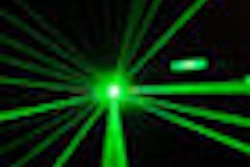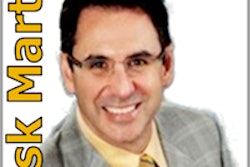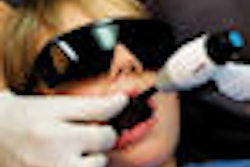
Lasers can reduce bacterial contamination and speed healing after implant surgery, according to a presentation at the annual meeting of the American Academy of Implant Dentistry.
Edward Kusek, D.D.S., is convinced of the benefits of erbium chromium lasers for endodontic and implant surgery. So much so that he doesn't charge his patients when he uses one.
"It's a win situation for the dentist because we can get things done faster," Dr. Kusek told DrBicuspid.com after giving a presentation on laser use at the annual meeting of the American Academy of Implant Dentistry. "And it's a win for the patient because they walk out of the office with an implant and crown and don't have to wear a removable appliance for three or four months."
— Edward Kusek, D.D.S.
Dr. Kusek, who has a private practice in Sioux Falls, S.D., has used the Biolase Waterlase -- an erbium chromium:yttrium scandium-gallium-garnet (Er;Cr:YSGG) laser -- with radial-emitting tips in his implant and endodontic surgeries for more than six years. He told meeting attendees that he has had only two implant failures out of the approximately 200 cases he has done in the last two years. Moreover, he said his laser-treated patients have reported less postoperative pain and faster healing and bone growth than did his pre-laser patients.
"Erbium and/or diode lasers can accelerate healing in dental surgery and are very effective for detoxifying an area to clear up infection," said Dr. Kusek. "In our practice and in several studies we have conducted, lasers have proven to stimulate better tissue growth and height and also foster stronger bone growth and better contact with the implant. As a result, we have cut the cycle time for most implant procedures from six to three months."
A few months ago, he began using the laser for a study to prove it can reduce bacteria in periodontal infections and apical infections from failed root canals. He took swabs at the extraction site before and after application of the laser and found it significantly disinfects the surgery sites and is effective against a wide range of both gram-negative and -positive bacteria. These include Porphyromonas gingivalis, Prevotella intermedia, beta-hemolytic Streptococci, Campylobacter (Wolinella) species, Capnocytophaga species, Fusobacterium and Peptostreptococcus enteric gram negative rods, Enterococcus species, Prevotella melaninogenica and non-pigmented Prevotella species.
Reducing the burden
Dr. Kusek began using this approach after several studies were published that demonstrated the ability of lasers to significantly reduce the bacterial burden at the surgical site (JADA, July 2007, Vol. 138, pp. 992-1002, and Lasers Surg Med. March 2000, Vol. 26, pp. 250-261).
He applies the laser to one or more sites for about 40 seconds each and then places the implant into the area where the tooth has been extracted. He then secures a temporary crown, takes impressions and the patient returns in three months for a permanent crown. In one published study, he showed there were better readings with a Periotest resonator in laser than in non-laser cases (Dent Today, October 2006, Vol. 25, pp. 98-103).
Dr. Kusek noted that laser treatment can be used in difficult cases. He recounted a case involving a young woman whose root canal failed because the root cracked. The area had become badly infected. He said he was able to perform the implant procedure in the normal way, with one appointment, resulting in a good outcome.
"Once the socket and surrounding area were detoxified by the laser treatment, the implant was inserted and a temporary crown attached," said Dr. Kusek. "Given the degree of infection, she would not have received an immediate-load implant in the same visit without the laser treatment."



















